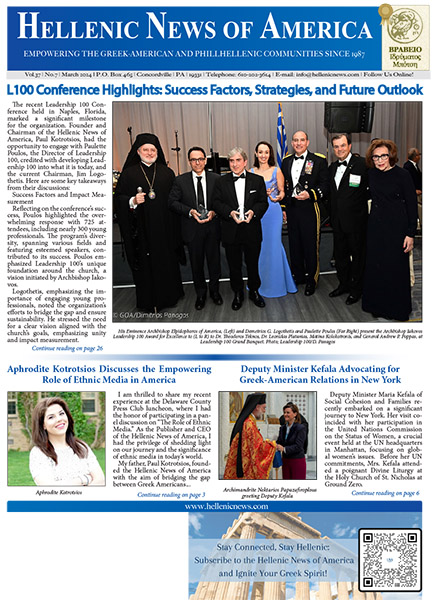Aigio, and its surrounding provincial region of Aigialeia, have been prominent in Greek recorded history since the 3rd millennium BC. Its wines were publicly praised as early as the 2nd century AD. Its cuisine, well, I’m writing about Greece – no further praise is necessary.

Traveling throughout Greece for six years makes it difficult to state that any region is more important than another. Yet this is the legendary Peloponnese. Mythology holds that the gods were born in the surrounding mountains before relocating north to Mount Olympus. From the 8th century BC to the 4th century AD Olympia, less than a two hour drive south from Aigio, was the sports magnet of its day – the Olympic Games.
Since the late 19th century the “inland sea” of the Corinthian Gulf separates the Peloponnese from mainland Greece. In the 1880s the Corinthian Canal was carved out of solid rock to make a sea link from the ancient city of Corinth on the eastern gulf to the Aegean.

The Aigion Museum, housed in the century old former Municipal Marketplace of Aigio, displays antiquities dating back four millenniums. Bilingual signage (Greek/English) leads the visitor on a chronological display of exquisite craftsmanship. The wealth and importance of both ancient Aigialeia, the provincial region to this day, mirrors the power of ancient Greece.

Many ancient artifacts have always been found intact in burial sites. They were possessions for the afterlife. Yet the imagination can run wild at the sight of a small pottery chair (1500 BC) that’s perfect size for a child’s dollhouse.

An 8th century BC 3-legged temple vessel could be a modern work of art. A 3rd and 1st century BC jewelry box and gold necklace with the Macedonian Star on top is extraordinarily detailed. And 2nd century AD Roman era glass shimmers with iridescence.
The prize of the museum is a statue of Zeus with the face of Medusa on his chest – the logo for the city of Aigio. Carved in the 1st century AD when under Roman rule, but very much in the Greek style. Even under foreign domination, the brilliance of Hellenic civilization seduced its conquers.
Only half of the old marketplace is currently exhibit space. Restoration on the remainder of the building is nearly complete. It will open in 2018 allowing much more of the museum’s extensive collection, now in storage, to be displayed.
Aigio itself is built on three levels: the seaside part, called Kato poli (Low city), the Galaxidiotika or Agios Antreas’ area, called Mesi poli (Middle city) and the Ano poli (High city) is the historical center. According to mythology, the Ionians of Attica, one of the four major tribes of ancient Greeks, founded the city in the middle of the 16th century BC. It soon became an important political and religious center along the Corinthian coast.
During the centuries after the Roman Empire Aigio passed to many conquerors, yet in January of 1821 it played a seminal role in modern Greek history. The Filiki Etairia (Society of Friends) met to plot the revolution (1821 – 1832) that would free much of Greece from Ottoman Empire rule. Aigio was one of the first cities liberated.

Greece has been producing wine for at least 6,500 years, estimated to be only a mere half millennium later than its ancient neighbor Thrace. Until Ottoman conquest in the 15th century Greek wine had been exported throughout the Mediterranean world, prized by the Romans and sought after even in northern Europe. Unfortunately under Ottoman Islamic laws commercial wine production virtually ended for 400 years.
Only over the past couple decades have production levels allowed for wider export to North American and European markets. Greek wines now routinely win international awards. That is certainly true with Rouvalis Winery.
High on the hills overlooking Aigio, the Aigialeia zone covers 5,000 hectares (12,400 acres) devoted to viticulture and currents. 80% of the land is planted in currents and 20% in wine grapes. The region is one of Earth’s largest producers of black currents, and since 1993 has been protected by a European Union P.D.O.

Theodora Rouvali, oinologist, is the second generation to manage Oenoforos – Rouvalis Winery. She’s passionate yet calm as she explains some the factors that set her winery apart.
Rouvalis produces labor-intensive organic wines. Harvesting is by hand. Yield is one ton per hectare. Normal harvest is four tons.
The zone is also a microclimate. The vines are always planted on the north side of the slopes, which allows for north breezes to ventilate the vineyard. South of the region are additional mountains on the Peloponnese that block the dry, hot southern winds.
Ninety percent of the vines are roditis for dry white wines, but the grape is a clone, which produces a red skinned variety that produces white wine. Roditis is planted at an altitude of 100 meters (328 feet) whereas riesling vines can thrive at 1,000 meters (3,280 feet).
Temperature differentials due to the altitude are beneficial for white grape varieties. According to Theodora, whereas Spanish and French grape production is suffering due to climate change (estimates of recent harvests down 40%) Greek production has yet to be compromised.
The winery facility itself is eco-friendly taking advantage of the mountain slope. It’s built on six levels with a “trickle down” gravity flow process from crushing through fermentation to storage.
The wines are generally dry with floral, citrus and complex fruit notes.

The Asprolithi (roditis) grape from the 900 meter altitude (2,950 feet) is a perfect example. Light, fresh with subtle grapefruit notes.
A classic malagousia was a touch more aromatic than the roditis with notes of white peach.
The red mavrodapnne grown at 500 meters (1,600 feet) is a grape of the P.G.I. Peloponnese. Because of its fruity flavors, it’s usually made into sweet wines with notes of cinnamon and cloves. But Rouvalis makes a distinctive dry variety. The nose catches aromas of ripe summer fruit on a warm day while in the mouth these flavors intensify – dried peaches and apricots. Dried currents round out the deep fruits, and the finish is silky.

One of their most prized and premium wines, is the Ianós Janus (Cabernet Sauvignon 2004) grown at 850 meters (2,800 feet). It is aged one year in French oak imparting a subtle smoky richness. Additional aging takes place in the bottle for 12 years developing a complex aromatic nose of dried red fruits (cherries, currents, raspberries) with an undertone of late summer roses. The flavors continue on the palate leaving the mouth dry and satisfied.
Rouvalis Winery is a major producer of Greek boxed wines. Considering its reputation for premium organic wines I questioned this side of production. Theodora was quite practical in that nowadays many restaurants and bars use boxed wines for their house varieties due to cost factors, yet quality can nearly equal traditional bottling.
A boxed syrah (2015) had light aromas of plumbs and smoky bacon. My mouth was not excited, but the fruity (dark berries) flavors were balanced with a touch of black pepper. It would easily pair with many meat and pasta dishes, and its smooth, light tannins would not bother people who prefer sweeter wines.
Since 2013 the ten day Oinoxeneia Festival in August is Aigio’s showcase of the region’s wine, cuisine and cultural. The 6th annual festival will take place 16-26 August 2018. It has rapidly become a major national summer attraction. Under the auspices of the Municipal Welfare Business of Aigialeia, the Oinoxeneia Festival is a fine example of cooperation between business and local government agencies.
A prodigious schedule of wine tastings, cooking demonstrations, tours of the region’s historic monasteries, concerts and special wine/food pairing menus at fine area restaurants would challenge even Bacchus!
The festival provides a good opportunity to ride the historic “toothy train” a special cog wheel narrow gauge railway that traverses the steep, beautiful, historic countryside. In winter it transports sport enthusiasts to ski resorts nearby.

As a chef I am aware of the pressure on succeeding generations to maintain the quality of a local culinary icon. Eleni Kougia – Tsagri and her son Marios have the task of keeping 65-year-old Palia Agora tou Aigiou (The Old Agora of Aigio, aka Taverna Old Market of Aigio) fresh yet traditional. Housed in the historic 1895 market and under ownership of the 3rd generation, there’s no trick; it’s keeping the hands in the business.

In the business is exactly what Chef Eleni demonstrated for me before lunch as she deftly handmade flaky phyllo dough for classic Tiropita. The fried feta cheese stuffed meze was a warm pillow.
Small, savory meat stuffed cabbage dolma in an aromatic stock were next on both the cooking list and menu. The rolls were certainly cousins to the popular more northern Balkan countries, but equally Greek. Greece is the southern most of the Balkan mountain system and culinary traditions are intertwined through millenniums of history.
At the table was a dish of braised rabbit redolent of the earthy aromas of fresh game. This classic dish is evidence of the abundance of meats especially in the mountainous interior of Greece.

Stratos Vardakis has created a Greek/American hybrid on Aigio’s tree shaded main square, Psila Alonia, Refrain Cafe Bar Restaurant. Open from early morning featuring Danesi Caffe through late night craft cocktails, its imaginative menu keeps even locals guessing. By its success, they enjoy their discoveries.
A great benefit of being a culinary travel writer is being in the kitchen watching the chefs prepare their dishes or give a demonstration. An even better benefit of being a chef as well is understanding why those flavors and techniques work.

Calamari to an American is often fried rings and to Greeks a char grilled staple to any lunch or dinner. At Refrain it becomes a fusion with a protected delicacy and an ancient pasta. In a dish that approaches a risotto, tender baby calamari is sautéed with scallions and red onions. Orzo pasta is added and steamed adding the local dried currents plumped in white wine, vegetable stock and a touch of tomato paste. Rich toasted pine nuts garnish the dish.
The texture contrasts are as interesting as the flavors. Creamy orzo pasta, crunchy pine nuts, soft calamari and small bombs of wine soaked dried red currents tantalize the senses.
Another classic international dish was enhanced by a simple twist –brandy. Sliced chicken breasts were sautéed with red onions and flamed with a generous amount of brandy. Partially cooked penne pasta was added along with vegetable stock, and simmered uncovered until tender. The dish was finished with enough crème freche or heavy cream to make it silky smooth.
A fresh ground beef burger was grilled with thick slices of tomato, onion, bacon and large oyster mushrooms. Feta cheese was wrapped in foil with scallions and red peppers, salt, pepper and olive oil and heated on the grill. An international lunch, yet all with local products.

Stin Kouzina restaurant is an additional gem to the Aigio food scene. I had the honor of a private dinner with the Apostolopoulos family. Like so many business enterprises in Greece, Stin Kouzina is a family affair with Dimitris, Chef Efi and their son Haris all involved. The menu is homage to Greek sea life and the abundance of the Corinthian Gulf.
In the Kitchen, which is the English translation of Stin Kouzina, I was again witness to the deft hands of an experienced chef as Efi Apostolopoulou prepared dinner.

Fileted anchovies were stuffed with a mixture of parsley, cheese, eggs and bread crumbs and seasoned with garlic, salt and pepper. They were lightly rolled in flour and sautéed in sunflower oil. Eli was insistent that sunflower oil be used as it does not add extra flavors to the fish that other oils would impart.
An imaginative salad was composed with mixed greens, pomegranate seeds, scallions and prized Aegina Island peanuts.
Married Sardines are sandwiches of two boneless sardines with a spread of herbs and olive oil. At Stin Kouzina they were then grilled, but they are often sautéed in other regions. They are popular throughout the Mediterranean world from Morocco to the Near East.
Fava spread with Santorini Island P.D.O. fava beans rounded out the small plates.

Bourgeto was the centerpiece of dinner. It is a traditional Greek baked fish dish with regional variations. At Stin Kouzina they used cod, peskandritsa (monkfish) and scorpion fish. The fish is arranged in an ovenproof dish, preferably ceramic, and covered with a puree of red onion and enough olive oil and aromatic fish stock to make a sauce. It’s baked in a preheated 425° F oven until fish flakes (20+ minutes).
As is typical for this culinary crossroads, Ekmek Kataifi is a traditional dessert of Ottoman Empire origin. It’s a type of bread pudding made with shredded phyllo, syrup and a thick layer of clotted cream smothering the top.
Besides the excellence of the menu, the rough warm rock interior and subdued lighting in the dinning room added to a relaxing evening.

The Corinthian Riviera, as the gulf region is known, is surrounded by mountains. Flat land and sandy beaches hug the shore. Towns and cities are stretched as well allowing for the development of many rental villas, guesthouses and resorts without crowding.
Several miles east of Aigio, the Gaia Apartments provide spacious, fully equipped, self-catering accommodations. Set in a quiet neighborhood close to beaches, the apartments surround an attractive garden. Besides all comforts, laundry facilities are provided, which is a great luxury when traveling.
 On a late soft summer afternoon my Aigio Municipal guide, Nansy Charitonidou, and I drove up through the vineyards and current fields of ancient Aigialeia. We stopped and visited Mr. Dimos at Gerofotis Guesthouse for drinks. It’s a beautiful stone house with panoramic views of the Gulf and surrounding hills.
On a late soft summer afternoon my Aigio Municipal guide, Nansy Charitonidou, and I drove up through the vineyards and current fields of ancient Aigialeia. We stopped and visited Mr. Dimos at Gerofotis Guesthouse for drinks. It’s a beautiful stone house with panoramic views of the Gulf and surrounding hills.
Like so many of my Greek experiences, especially at the end of the day, an extraordinary calm settled over all. High on the hills in Lakka above Aigio in the Peloponnese in the garden of Gerofotis Guesthouse a dog barked in the background, soft jazz played, vineyards spilled down the hillsides, the Corinthian Gulf was calm – a serene evening in Greece. The only reason you need to visit Aigio.
When you go: Aigio is an easy 2 hour drive from Athens by car or frequent bus (coach) connections. A new superhighway (tolls) links Athens to all destinations along the southern Corinthian Gulf coast.
Disclaimer: the author was a guest of the Municipality of Aigio and all businesses mentioned in this article. The reviews are the author’s independent evaluations. Special thanks to Nansy Charitonidou, Aigio Municipality, and Maria Tsoukala, President of the Municipal Welfare Business of Aigialeia. Transportation was provided by Avance Rent A Car. Arrangements were facilitated by the MTC Group, Athens.
Travel with Pen and Palate every month to Greece and the world in the Hellenic News of America.

Oinoxeneia Festival: http://oinoxeneia.gr/en/
“toothy train” http://www.trainose.gr/en/tourism-culture/train-and-recreation/the-rack-railway/






